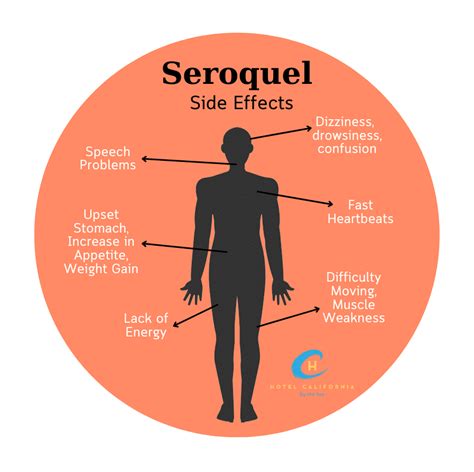Intro
Seroquel, also known by its generic name quetiapine, is a type of antipsychotic medication that is used to treat various mental health conditions. It is primarily prescribed to manage symptoms of schizophrenia, bipolar disorder, and major depressive disorder. Seroquel works by altering the levels of certain chemicals in the brain, such as dopamine and serotonin, which are involved in mood regulation and other cognitive functions. By adjusting these chemical balances, Seroquel can help reduce symptoms such as hallucinations, delusions, mood swings, and anxiety.
The importance of understanding Seroquel and its effects cannot be overstated, given the significant impact that mental health conditions can have on individuals and their families. Mental health issues are prevalent and can affect anyone, regardless of age, background, or socioeconomic status. Effective treatment options like Seroquel are crucial for managing symptoms, improving quality of life, and facilitating recovery. Moreover, awareness about medications such as Seroquel helps reduce stigma around mental illness and encourages those who need help to seek it without fear of judgment.
Seroquel's role in modern psychiatry is multifaceted. It is not only used for its primary indications but also explored for off-label uses due to its unique pharmacological profile. The drug's ability to act on multiple neurotransmitter systems makes it a valuable tool in the psychiatrist's arsenal. However, like all medications, Seroquel comes with potential side effects and risks, which must be carefully considered and monitored by healthcare professionals. Understanding the benefits and risks of Seroquel is essential for patients, caregivers, and healthcare providers to make informed decisions about its use.
How Seroquel Works

Seroquel's mechanism of action involves the modulation of dopamine and serotonin receptors in the brain. Dopamine is associated with the reward and pleasure centers of the brain, and imbalances in dopamine levels can lead to symptoms of psychosis, such as hallucinations and delusions. Serotonin, on the other hand, is involved in mood regulation, appetite, and sleep. By affecting these neurotransmitter systems, Seroquel can help stabilize mood, reduce psychotic symptoms, and improve overall mental health.
The drug's pharmacokinetics, including its absorption, distribution, metabolism, and excretion, influence how it is administered and its dosing schedule. Seroquel is typically taken orally, with or without food, once or twice daily, depending on the specific formulation and the condition being treated. Its metabolism primarily occurs in the liver, and it is excreted through the kidneys. Understanding these pharmacokinetic properties is crucial for optimizing its therapeutic effects and minimizing potential side effects.
Benefits of Seroquel
The benefits of Seroquel are multifaceted and can significantly improve the quality of life for individuals with mental health conditions. Some of the key advantages include: - **Effective Symptom Management**: Seroquel is effective in reducing symptoms of schizophrenia, bipolar disorder, and major depressive disorder, leading to improved functioning and reduced risk of relapse. - **Mood Stabilization**: It helps in stabilizing mood, reducing the extremes of mania and depression associated with bipolar disorder. - **Anxiety Reduction**: Seroquel can also help reduce anxiety, which is often a comorbid condition with the primary diagnoses it treats. - **Improved Sleep**: Many patients report improved sleep quality while taking Seroquel, which is beneficial given the high prevalence of sleep disturbances in mental health conditions.Seroquel Side Effects and Risks

While Seroquel is an effective treatment for many, it is not without potential side effects and risks. Common side effects include drowsiness, dry mouth, dizziness, and weight gain. More serious but less common risks include increased risk of stroke and transient ischemic attack in elderly patients with dementia, metabolic changes, and an increased risk of suicidal thoughts or behaviors, especially in children and adolescents.
It is crucial for patients and their caregivers to be aware of these potential side effects and to work closely with healthcare providers to monitor their condition and adjust treatment as necessary. Regular follow-up appointments, open communication about any changes in symptoms or side effects, and adherence to the prescribed treatment plan are key components of safe and effective Seroquel use.
Steps for Taking Seroquel
To get the most out of Seroquel treatment and minimize risks, patients should follow these steps: 1. **Adhere to the Prescribed Dose**: Take Seroquel exactly as prescribed by your healthcare provider. Do not adjust your dose without consulting them first. 2. **Maintain Regular Follow-Up**: Regular appointments with your healthcare provider are crucial for monitoring your condition and adjusting your treatment plan as needed. 3. **Monitor for Side Effects**: Keep a journal or use an app to track any side effects or changes in your condition. This information is invaluable for your healthcare provider in making informed decisions about your care. 4. **Lifestyle Modifications**: Healthy lifestyle choices, such as a balanced diet, regular exercise, and avoiding alcohol and drugs, can complement your treatment and improve overall well-being.Seroquel in Pregnancy and Breastfeeding

The use of Seroquel during pregnancy and breastfeeding requires careful consideration. While there is limited data on the use of quetiapine in pregnant women, animal studies suggest potential risks. Therefore, Seroquel should only be used during pregnancy if the benefits outweigh the risks. For breastfeeding mothers, it is known that quetiapine is excreted in human milk, and caution should be exercised. Decisions about continuing or stopping Seroquel during pregnancy or breastfeeding should be made in consultation with a healthcare provider.
Alternatives to Seroquel
For patients who may not respond well to Seroquel or experience intolerable side effects, there are alternative treatments available. These can include other antipsychotic medications, mood stabilizers, or antidepressants, depending on the specific condition being treated. In some cases, psychotherapy, such as cognitive-behavioral therapy (CBT) or family-focused therapy, may be recommended alone or in combination with medication.Conclusion and Future Directions

In conclusion, Seroquel is a valuable medication in the treatment of various mental health conditions. Its effectiveness in managing symptoms of schizophrenia, bipolar disorder, and major depressive disorder has improved the lives of many individuals. However, like all medications, it must be used judiciously, with careful consideration of its benefits and risks. Ongoing research into the mechanisms of action of Seroquel and its long-term effects will continue to inform its use and potentially lead to the development of new treatments.
As we look to the future, the importance of mental health awareness and the reduction of stigma around mental illness cannot be overstated. Encouraging open discussions about mental health, supporting research into new and innovative treatments, and ensuring access to quality care for all who need it are critical steps forward. By working together, we can create a society that values mental health as equally as physical health, leading to a better quality of life for everyone.
Final Thoughts
The journey towards mental wellness is unique for each individual, and what works for one person may not work for another. Seroquel, with its broad range of applications and effectiveness, is a testament to the progress made in psychiatric medication. However, it is just one part of a comprehensive approach to mental health that includes therapy, lifestyle changes, and social support. By embracing a holistic view of health and wellness, we can foster a supportive environment where individuals feel empowered to seek help and thrive.What is Seroquel used for?
+Seroquel, also known as quetiapine, is used to treat schizophrenia, bipolar disorder, and major depressive disorder.
How does Seroquel work?
+Seroquel works by affecting the levels of certain chemicals in the brain, such as dopamine and serotonin, which are involved in mood regulation and other cognitive functions.
What are the common side effects of Seroquel?
+Common side effects of Seroquel include drowsiness, dry mouth, dizziness, and weight gain. More serious side effects can include increased risk of stroke and transient ischemic attack in elderly patients with dementia, metabolic changes, and an increased risk of suicidal thoughts or behaviors.
We invite you to share your thoughts and experiences with Seroquel and mental health treatment in the comments below. Your stories and insights can provide valuable support and information to others who are navigating similar journeys. Let's work together to create a more open and supportive community around mental health.
